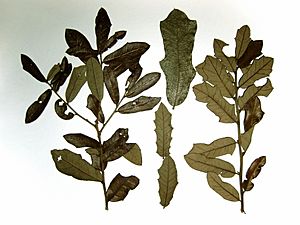Dwarf live oak facts for kids
Quick facts for kids Dwarf live oak |
|
|---|---|
 |
|
| Scientific classification | |
| Genus: |
Quercus
|
| Species: |
minima
|
| Synonyms | |
|
List
Quercus virens var. dentata Chapm.
Quercus virginiana var. minima Sarg. Quercus andromeda f. nana Trel. Quercus geminata var. succulenta (Small) Trel. Quercus minima f. pygmaea (Sarg.) Trel. Quercus minima var. pygmaea (Sarg.) A.Camus Quercus minima f. reasoneri Trel. Quercus pygmaea (Sarg.) Ashe Quercus succulenta Small Quercus virginiana subsp. dentata (Chapm.) A.E.Murray Quercus virginiana var. dentata (Chapm.) Sarg. Quercus virginiana var. pygmaea Sarg. |
|
The dwarf live oak (Quercus minima), also called the minimal oak, is a type of small tree or shrub. It belongs to the beech family, which includes many kinds of oaks. This plant is found naturally in the southeastern parts of the United States.
Contents
Dwarf Live Oak: A Small but Mighty Plant
The dwarf live oak is special because it usually grows as a shrub, not a tall tree. It rarely gets taller than 2 meters (about 6.7 feet). This plant is known for being very tough and spreading out.
What Does It Look Like?
The dwarf live oak is an evergreen or semi-evergreen plant. This means it keeps its leaves all year round, or at least for most of the year. Its leaves are about 12 centimeters (4.8 inches) long. They can be smooth on the edges or have uneven teeth or pointy parts called lobes. If the leaves have lobes, these usually end in a small spine. The old leaves fall off in late winter or early spring, just as new ones start to grow.
Where Does It Live?
This plant is native to the coastal plain of the southeastern United States. You can find it mostly in Florida. However, its range also stretches into the Carolinas and the eastern part of Louisiana. It likes to grow in these warm, often sandy, areas near the coast.
How Does It Grow and Spread?
The dwarf live oak can grow from seeds, just like many other plants. But it also has a special way of spreading using underground stems called rhizomes. These rhizomes grow horizontally under the soil. They can send up new shoots, creating many stems that are all connected to the same original plant. This allows the dwarf live oak to form large groups of plants that are actually all part of one big "cloned colony." Many of these stems do not even have branches.
See also
 In Spanish: Quercus minima para niños
In Spanish: Quercus minima para niños


